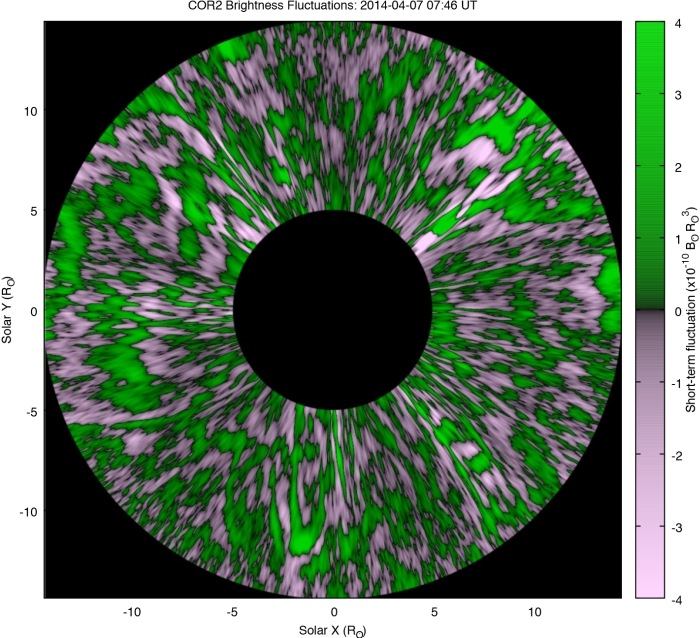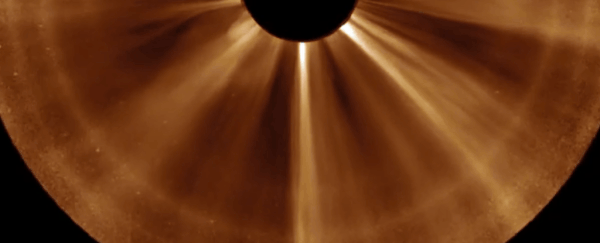Using longer exposures and sophisticated processing techniques, scientists have taken extraordinarily high-fidelity pictures of the Sun's outer atmosphere - what we call the corona - and discovered fine details that have never been detected before.
The Sun is a complex object, and with the soon-to-be-launched Parker Solar Probe we're on the verge of learning so much more about it. But there's still a lot we can do with our current technology, as scientists from the Southwest Research Institute (SwRI) have just demonstrated.
The team used the COR-2 coronagraph instrument on NASA's Solar and Terrestrial Relations Observatory-A (STEREO-A) to study details in the Sun's outer atmosphere.
This instrument takes images of the atmosphere by using what is known as an occulting disc - a disc placed in front of the lens that blocks out the actual Sun from the image, and therefore the light that would overwhelm the fine details in the plasma of the Sun's atmosphere.
The corona is extremely hot, much hotter than the inner photosphere's 5,800 Kelvin, coming in at between 1 and 3 million Kelvin. It's also the source of solar wind - the constant stream of charged particles that flows out from the Sun in all directions.
When measurements of the solar wind are taken near Earth, the magnetic fields embedded therein are complex and interwoven, but it's unclear when this turbulence occurs.
"In deep space, the solar wind is turbulent and gusty," says solar physicist Craig DeForest of the SwRI.
"But how did it get that way? Did it leave the Sun smooth, and become turbulent as it crossed the solar system, or are the gusts telling us about the Sun itself?"
If the turbulence was occurring at the source of the solar wind - the Sun - then we should have been able to see complex structures in the corona as the cause of it, but previous observations showed no such structures.
Instead, they showed the corona as a smooth, laminar structure. Except, as it turns out, that wasn't the case. The structures were there, but we hadn't been able to obtain a high enough image resolution to see them.
 (NASA/SwRI/STEREO)
(NASA/SwRI/STEREO)
"Using new techniques to improve image fidelity, we realised that the corona is not smooth, but structured and dynamic," DeForest explains. "Every structure that we thought we understood turns out to be made of smaller ones, and to be more dynamic than we thought."
To obtain the images, the research team ran a special three-day campaign wherein the instrument took more frequent and longer-exposure images than it usually does, allowing more time for light from faint sources to be detected by the coronagraph. But that was only part of the process.
Although the occulting disc does a great job at filtering out the bright light from the Sun, there's still a great deal of noise in the resulting images, both from the surrounding space and the instrument.
Obviously, since STEREO-A is in space, altering the hardware isn't an option, so DeForest and his team worked out a technique for identifying and removing that noise, vastly improving the data's signal-to-noise ratio.

They developed new filtering algorithms to separate the corona from noise, and adjust brightness. And, perhaps more challengingly, correct for the blur caused by the motion of the solar wind.
They discovered that the coronal loops known as streamers - which can erupt into the coronal mass ejections that send plasma and particles shooting out into space - are not one single structure.
"There is no such thing as a single streamer," DeForest said. "The streamers themselves are composed of myriad fine strands that, together, average to produce a brighter feature."
They also found there's no such thing as the Alfvén surface - a theoretical, sheet-like boundary where the solar wind starts moving forward faster than waves can travel backwards through it, and it disconnects from the Sun, moving beyond its influence.
Instead, DeForest said, "There's a wide 'no-man's land' or 'Alfvén zone' where the solar wind gradually disconnects from the Sun, rather than a single clear boundary."
But the research also presented a new mystery to probe, as well. At a distance of about 10 solar radii the solar wind suddenly changes character. But it returns to normal farther out from the Sun, indicating that there's some interesting physics happening at 10 solar radii.
Figuring out what that is may require some help from Parker, for which this research is key. Parker is due to launch in August.
Meanwhile, the team's research has been published in The Astrophysical Journal.
